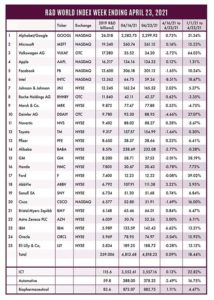
The R&D World Index (RDWI) for the week ending April 23, 2021 closed at 4,818.23 for the 25 companies in the R&D World Index. The Index was up 0.09% (or 4.55 basis points) from the week ending April 16, 2021. The stock of 13 R&D World Index members gained value from 0.12% (Apple) to 6.62% (IBM). The stock of 12 R&D World Index members lost value from -0.08% (Ford) to -8.51% (Intel).
The U.S. National Security Commission on Artificial Intelligence (NSCAI) was created in 2018 to address the U.S.’s national security needs for the development of AI, machine learning and associated technologies. The NSCAI published interim reports in 2019 and 2020. Its 746-page Final Report was sent to the President and Congress in March with the conclusion that “America is not prepared to defend or compete in the AI era.” The Final Report includes a proposed $40 billion budget for hybrid government and private sector R&D investments through 2025 to allow the U.S. to compete and stay ahead of Chinese and other U.S. adversarial resources. Of that funding, about $10 billion would be spent for Department of Defense activities, $15 billion for the Commerce Department, and $1 billion each for the National Science Foundation, the National Institute of Standards and Technology (NIST), the State Department, national intelligence agencies and the (new) National Technology Foundation. In an unrelated action, the European Union’s executive arm last week proposed a bill that would limit the use of high-risk AI technologies for critical infrastructures, including facial recognition in policing actions, college admissions and loan applications.
The U.S. Centers for Disease Control and Prevention (CDC) and the U.S. Food and Drug Administration (FDA) late last week advised that vaccinations with Johnson & Johnson’s COVID-19 one-shot vaccine could resume after researchers’ investigation of rare blood-clotting side effects were found to be outweighed by the benefits of the vaccine. The risk of blood clots was found to be much higher in the COVID-19 virus itself than in the vaccines associated with these complications, according to hematology researchers at Brigham and Women’s Hospital in Boston, who participated in the analysis. The European Medicines Agency (EMA) and the FDA will likely add a warning notice to the J&J vaccines allowing doctors to know how to treat the rare blood clotting condition.
Rivals of Space Exploration Technologies (SpaceX) Starlink internet satellite venture are challenging the safety and competitiveness of the expanding Starlink network. SpaceX currently operates more than 1,300 spacecraft in low-earth orbit (LEO) and is adding about 120 more every month with a current goal of 12,000. They are seeking U.S. (Federal Communications Commission, FCC) and European regulatory permission for an additional 30,000 spacecraft. Starlink rivals include Viasat, OneWeb Global, Hughes Network Systems and Boeing. Starlink spacecraft don’t have the ability to maneuver and if a collision with another spacecraft is imminent, the other spacecraft has to maneuver out of the way, with both traveling at approximately 18,000 mph. A collision would spread high-velocity debris over a wide orbital range.
President Joe Biden proposed last week that the U.S. would cut its greenhouse-gas emission in half by 2030 from the levels set in 2005. U.S. emissions in 2020 were already down by 21% from the 2005 level, in part due to the pandemic-induced economic slowdown. Analysts point out that meeting the 2030 target will be difficult, especially in the heavy industry areas, such as steel, cement and petrochemical production which require large amounts of energy and emit substantial emissions. Agriculture and transportation industries will also be difficult, but many are already on track to cut their emissions. Leaders of other countries, including China, the European Union and India, were generally supportive of Biden’s proposals, but on their own terms.
The U.S. and Japan agreed jointly last week to invest more than $4.5 billion to “cooperate in the research, development testing and deployment of secure networks and advanced information and communication technologies” beyond 5G or 6G. The two countries will launch a Global Digital Connectivity Partnership to promote secure 6G connectivity to address shared commercial threats (from China, Russia and North Korea). In a separate announcement, Germany stated that it is dedicating near $850 million over the next five years for an innovative ecosystem for future communication technologies based on 6G. The European Commission (EC) has already created a $1.1 billion initiative called the Joint Undertaking on Smart Networks and Services (SNS) towards 6G.
China’s Ministry of Finance last week released the Announcement on Further Improving the Policy for Pre-Tax Additional Deductions for R&D Expenses. The announcement, retroactive to January 1, 2021, increases the ratio of additional deductions on manufacturing firms’ R&D expenses from 75% to 100%. This policy is designed to boost enterprises’ R&D input, incentivize business innovation and advance industrial upgrades. The policy will reduce corporate taxes by about $12 billion in 2021, on top of the $55 billion tax cuts put in place in 2020.
Nvidia’s $40 billion plan to acquire the UK’s chip design firm Arm from SoftBank Group Corp. is being reviewed by the UK government for national security implications. A report is due by July 30, 2021. The security review comes on top of an anti-trust review. Nvidia’s acquisition is also expected to face regulatory scrutiny in China, the European Union and the U.S. because of its potential to reshape the semiconductor chip industry. Nvidia is one of the world’s largest designers of graphics processors, while Arm designs the basic blueprints for the chips in more than 95% of the world’s smartphones.
Energy giants Exxon Mobile, Total, BP, Equinor ASA and Royal Dutch Shell PLC are shifting their focus from petrochemical research and development to carbon capture and storage, according to industry analysts. Exxon has said it plans to form a new business unit to commercialize carbon capture and storage, forecasting it could become a $2 trillion market by 2040. Shell already captures and stores its own carbon at sites in Australia and Canada and wants to develop additional commercial facilities. Seventeen new carbon capture projects were forecast to be started in 2020.
R&D World’s R&D Index is a weekly stock market summary of the top international companies involved in R&D. The top 25 industrial R&D spenders in 2019 were selected based on the latest listings from Schonfeld & Associates’ June 2020 R&D Ratios & Budgets. These 25 companies include pharmaceutical (10 companies), automotive (6 companies) and ICT (9 companies) who invested a cumulative total of nearly 260 billion dollars in R&D in 2019, or approximately 10% of all the R&D spent in the world by government, industries and academia combined, according to R&D World’s 2021 Global R&D Funding Forecast. The stock prices used in the R&D World Index are tabulated from NASDAQ. NYSE, and OTC common stock prices for the companies selected at the close of stock trading business on the Friday preceding the online publication of the R&D World Index.



Tell Us What You Think!